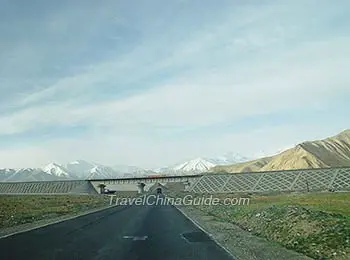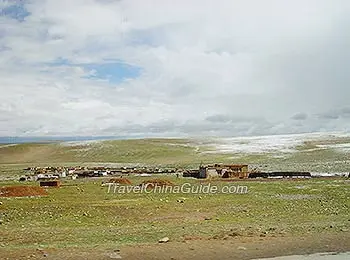As the Tibet Railway traverses mountain ranges, grasslands, rivers, and passes by glacier and lakes on its way to 'the Roof of the World' (Qinghai-Tibet Plateau), the scenery along it is as majestic and breathtaking as a painting. The Mani Stones, prayer flags, Tibetan folk houses, antelope, yak, wild donkeys, cranes, mandarin ducks and swans make this painting a vivid and lively one.
Jinyintan Prairie
Running west out of Xining, the train will climb higher and higher as the altitude rises, where vegetation becomes exiguous and land is sparsely populated. Suddenly, passengers will be amazed by a vast land carpeted by luxurious green grass and blossoming small flowers. This is the Jinyintan Prairie, located 75 miles (120 kilometers) away from downtown Xining. Covering an area of 425 square miles (1100 square kilometers), this fertile land has beautiful scenery and plenty of wildlife. The best time to appreciate it is July to September, when many will be drawn here to enjoy the splendid scene.
To the west of Jinyintan Prairie, is the largest inland salt water lake in China, Qinghai Lake. The rail line extends along its north bank, when passengers can see a large area of clear water and reflections of distant snow capped mountains. The most beautiful time of the lake is July and August, when the surrounding cole flowers are in full bloom. The golden waves of cole flowers, the dark blue water and the bright sunlight resemble a beautiful oil painting. Even when it is in cold winter, the enchantment of Qinghai Lake remains and attracts numerous people to admire the distinctive winter scenery.
Qarhan Salt Lake
The next amazing scenery following Qinghai Lake is the Qarhan Salt Lake. Highlight of this salt lake is the “Long Salt Bridge”, a broad road made of salt across the lake. The road, with a total length of 19.8 miles (32 kilometers), is like a bridge floating over the brine, so it is praised as “Long Salt Bridge”. It is a rare scene seldom seen. The railway bed passing here is also built with all kinds of salt crystals.
 |
| Tibet Railway in Kunlun Mountain Area |
Keep going and, after a short stop in Golmud, a city built in the Tsaidam Basin, the train will start its journey inside the ‘belly’ of Kunlun Mountains, which is the basic skeleton of the plateau landscape and a vital natural boundary line of Qinghai Province. Looking through the windows, passengers can even see its east peak, Mt. Yuzhu; with an altitude of 20,269 feet (6,178 meters) above sea level, covered by snow and glaciers even in summer. This section of rail line runs through many elevated bridges and tunnels, including the famous Kunlun Mountains Tunnel, known as the world’s longest permafrost tunnel. When leaving the tunnel, passengers may see a few Taoist shrines, prayer flags and Mani Stones of
Tibetan Buddhism, and stone steles and blur stone statues. Although plain and simple, it is a glimpse of local people’s lives.
The train will carry on into Hoh Xil, China’s largest and the world’s third largest unpopulated areas. The basic scenery comprises jokul, gorge, stone forest, and saline. Although unpopulated, there are many rivers and animals living here. If lucky, passengers may see rare wild animals like Tibetan antelope and yak. A section of the railroad, about 12 miles long, is especially elevated like a bridge, so animals can migrate as before. Another two bridges over Chamuer River and Tuotuo River (upper reach of
Yangtze River) along this section are also very grand and worth seeing. The rail line in this area seldom deviates and runs straight to the ‘heaven’, a good description of the reputation of the Tibet Railroad, ‘Heavenly Road’.
Tanggula Mountains
Move on, the train will climb over its highest section in Tanggula Mountains. The oxygen here is only about 60% of the plains. The world’s highest railway station, Tanggula Station, is located here. It has an altitude of 16,627 feet (5,068 meters). Looking to the west from the station, one will become intoxicated with the charismatic scenery of the mountain covered with snow all year around. Also, the vast plains, lakes, Tanggula River and glacier are within one's sight too.
 |
| Grand Landscape of Nakchu |
Winding out of the Tanggula Mountains, the train will pull into Nagqu, an important county in northern Tibet. Nakchu Railway Station stands on the Qiangtang Pasture, which is one of the five biggest pastures in China. From the station, splendid vistas of clear blue sky, lakes, plains, flocks of wild birds and the magnificent jokul are all within the passengers' vision. The Qiangtang Pasturehas a great reputation, and every year in August, the Nakchu Horse Race is held here attracting many visitors.
Cuona Lake
The train will pass Cuona Lake soon afterwards. With the nearest shore only tens of yards away, passengers can enjoy the serenity of the lake with great ease. Covering an area of over 154 square miles (400 square kilometers), Cuona Lake is regarded as the highest freshwater lake in the world. Like
Namtso Lake in Lhasa, Cuona Lake means 'Heavenly Lake' to the locals, attracting numerous worshippers. The water here is crystal clear with fish jumping freely. Together with the boundless grassland and clear sky, the scenery surrounding Cuona Lake is of great beauty, attracting cranes, mandarin ducks, swans and other wild animals. The train will then pass Damxung. Abundant with grasslands, it is also famous for its horse race.
Nyainqentanglha Mountains
Next, the railroad will travel through another mountain range, Nyainqentanglha Mountains. These are the final mountains the railroad need the go through before reaching its destination. At the mountain pass, a giant prayer flag is hung to worship the Mountain God. If it is sunny, passengers can appreciate the gorgeous Nyainqentanglha mountain peak, which rises even above the clouds.
Keep heading south, one will be surprised to see some hot gases rise from the earth through natural outlets. This is Yangpachen, a place rich in earth heat resources and hot springs. The hottest namma in China and the largest earth heat power plant are situated here.
Dagze County
The train will then go through a valley with a fast flowing river. Although the altitude is not as high as previously, it is steeper and more dangerous. When reaching Dagze County, the valley widens, the altitude suddenly gets lower, and climate becomes pleasant. Passengers will see trees again as well as small villages. What beautiful idyllic scenery!
With the valley widening even further, the train enters Lhasa river valley, passes by the grand Lhasa River Bridge, and finally reaches its destination, Lhasa. Here, passengers can visit the famous
Potala Palace,
Norbulingka,
Jokhang Temple and
Barkhor Street, etc.

Further Reading:
8 Most Scenic Train Rides in China
